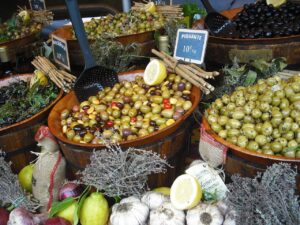Calissons are a speciality of Aix-en-Provence. A delicious candy, made from crystallised melons and almonds, lovingly crushed together and then coated in icing. These pointed-oval shaped treats have been a delicacy in Aix-en-Provence since the fifteenth century.
How Are Calissons Made?
It requires delicate preparation. It is a secret recipe, using products from Provence, including orange blossoms, almonds, and candied melons. Only a few workshops in the area make these treats the traditional way. The recipe calls for forty percent almonds and sixty percent candied fruit, which are then mixed with a syrup, along with orange blossom water.
The dough is placed on a thin wafer of unleavened bread and covered in an icing mixture, giving it a satin white appearance. Once cooked, they are carefully placed in boxes to retain their unusual oval shape.
What Are the Main Ingredients of Calissons?
The two main ingredients includes candied melon and almonds. Almonds were first introduced to France in the eighth century, where Provence had the ideal growing climate. Almonds are an important part of Calissons, adding to their delicious and unique flavour.
The second main ingredient is the Carpentras Melon. A round fruit that has a sweet and juicy flesh. It was introduced to France in the fifteenth century. Together with the almonds, the Carpentras Melon adds a sweet and subtle flavour to the treat.
Are There Variations to the Traditional Calisson?
The almond-based calisson is traditionally made with Carpentras Melon, but many confectioneries in Aix-en-Provence experiment with different fruits including mandarin oranges, pears, figs, raspberries, and lemons.
What is the Legend of Calisson in Aix-en-Provence?
It is believed that King Rene left his wife on a regular basis to go hunting. She was lonely and bored waiting for the king’s return, succumbing to the advances of a pastry chef. He came up with a melting candy to please her.
Yet there is another story. It is also believed that calissons were made for King Rene’s wedding feast in Aix-en-Provence in 1473. Interestingly, Calisson was mentioned in medieval Latin in the twelfth century, closely related to Italian terms.
Whether it originated in Aix-en-Provence or not, the area proved favourable for the growth of the ingredients, and it is today a delectable piece of history that can be enjoyed by locals and visitors alike. The town remains the most important in the almond market today.
Calissons and Special Occasions
In the seventeenth century, calissons were handed out by the Church to its congregation for Christmas, Easter, and the 1st September. The calissons were blessed by the archbishop and handed out in church vases. It was offered in the same way as hosts during mass. Some people still believe that calissons have the pore to preserve devout Catholics from contagions.
A Melting Moment
If you have plans to visit Aix-en-Provence, be sure to try calissons for a traditional and unique dessert experience. These little packages are filled with flavour, melting in your mouth. Do you want to find out more? Get in touch with Cooking Classes in Provence today.




